Binyi Su
Senior Member, IEEE
Photovoltaic Defect Image Generator with Boundary Alignment Smoothing Constraint for Domain Shift Mitigation
May 09, 2025Abstract:Accurate defect detection of photovoltaic (PV) cells is critical for ensuring quality and efficiency in intelligent PV manufacturing systems. However, the scarcity of rich defect data poses substantial challenges for effective model training. While existing methods have explored generative models to augment datasets, they often suffer from instability, limited diversity, and domain shifts. To address these issues, we propose PDIG, a Photovoltaic Defect Image Generator based on Stable Diffusion (SD). PDIG leverages the strong priors learned from large-scale datasets to enhance generation quality under limited data. Specifically, we introduce a Semantic Concept Embedding (SCE) module that incorporates text-conditioned priors to capture the relational concepts between defect types and their appearances. To further enrich the domain distribution, we design a Lightweight Industrial Style Adaptor (LISA), which injects industrial defect characteristics into the SD model through cross-disentangled attention. At inference, we propose a Text-Image Dual-Space Constraints (TIDSC) module, enforcing the quality of generated images via positional consistency and spatial smoothing alignment. Extensive experiments demonstrate that PDIG achieves superior realism and diversity compared to state-of-the-art methods. Specifically, our approach improves Frechet Inception Distance (FID) by 19.16 points over the second-best method and significantly enhances the performance of downstream defect detection tasks.
Unveiling the Unknown: Conditional Evidence Decoupling for Unknown Rejection
Jun 26, 2024Abstract:In this paper, we focus on training an open-set object detector under the condition of scarce training samples, which should distinguish the known and unknown categories. Under this challenging scenario, the decision boundaries of unknowns are difficult to learn and often ambiguous. To mitigate this issue, we develop a novel open-set object detection framework, which delves into conditional evidence decoupling for the unknown rejection. Specifically, we select pseudo-unknown samples by leveraging the discrepancy in attribution gradients between known and unknown classes, alleviating the inadequate unknown distribution coverage of training data. Subsequently, we propose a Conditional Evidence Decoupling Loss (CEDL) based on Evidential Deep Learning (EDL) theory, which decouples known and unknown properties in pseudo-unknown samples to learn distinct knowledge, enhancing separability between knowns and unknowns. Additionally, we propose an Abnormality Calibration Loss (ACL), which serves as a regularization term to adjust the output probability distribution, establishing robust decision boundaries for the unknown rejection. Our method has achieved the superiority performance over previous state-of-the-art approaches, improving the mean recall of unknown class by 7.24% across all shots in VOC10-5-5 dataset settings and 1.38% in VOC-COCO dataset settings. The code is available via https://github.com/zjzwzw/CED-FOOD.
Towards Few-Shot Open-Set Object Detection
Oct 28, 2022



Abstract:Open-set object detection (OSOD) aims to detect the known categories and identify unknown objects in a dynamic world, which has achieved significant attentions. However, previous approaches only consider this problem in data-abundant conditions. We seek a solution for few-shot open-set object detection (FSOSOD), which aims to quickly train a detector based on few samples while detecting all known classes and identifying unknown classes. The main challenge for this task is that few training samples tend to overfit on the known classes, and lead to poor open-set performance. We propose a new FSOSOD algorithm to tackle this issue, named FOOD, which contains a novel class dropout cosine classifier (CDCC) and a novel unknown decoupling learner (UDL). To prevent over-fitting, CDCC randomly inactivates parts of the normalized neurons for the logit prediction of all classes, and then decreases the co-adaptability between the class and its neighbors. Alongside, UDL decouples training the unknown class and enables the model to form a compact unknown decision boundary. Thus, the unknown objects can be identified with a confidence probability without any pseudo-unknown samples for training. We compare our method with several state-of-the-art OSOD methods in few-shot scenes and observe that our method improves the recall of unknown classes by 5%-9% across all shots in VOC-COCO dataset setting.
SIGAN: A Novel Image Generation Method for Solar Cell Defect Segmentation and Augmentation
Apr 11, 2021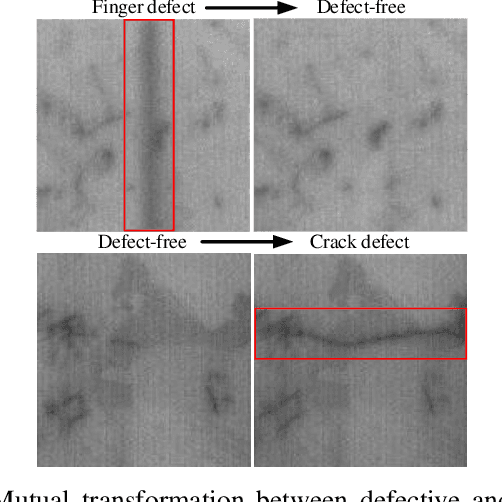
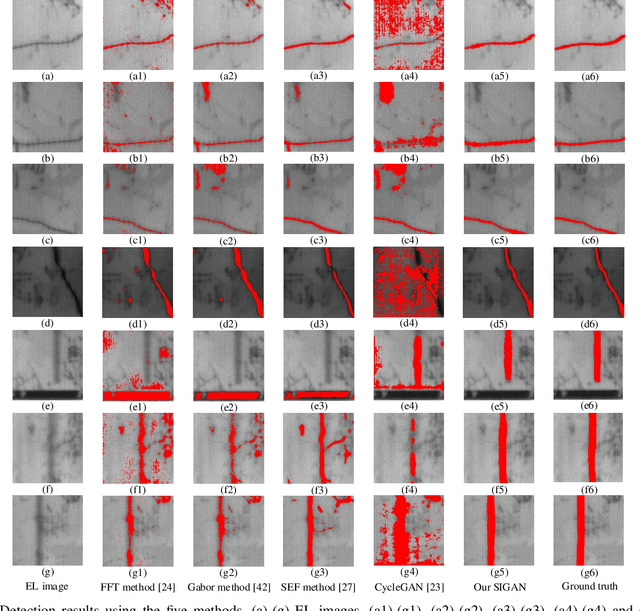
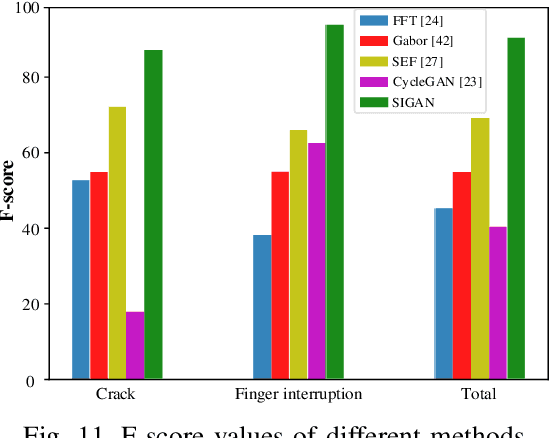
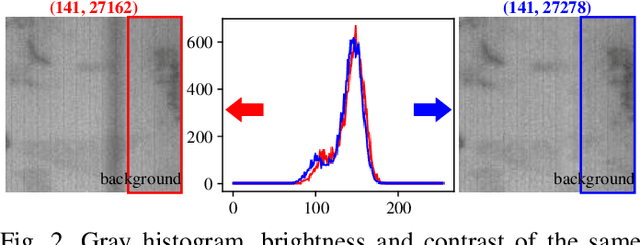
Abstract:Solar cell electroluminescence (EL) defect segmentation is an interesting and challenging topic. Many methods have been proposed for EL defect detection, but these methods are still unsatisfactory due to the diversity of the defect and background. In this paper, we provide a new idea of using generative adversarial network (GAN) for defect segmentation. Firstly, the GAN-based method removes the defect region in the input defective image to get a defect-free image, while keeping the background almost unchanged. Then, the subtracted image is obtained by making difference between the defective input image with the generated defect-free image. Finally, the defect region can be segmented through thresholding the subtracted image. To keep the background unchanged before and after image generation, we propose a novel strong identity GAN (SIGAN), which adopts a novel strong identity loss to constraint the background consistency. The SIGAN can be used not only for defect segmentation, but also small-samples defective dataset augmentation. Moreover, we release a new solar cell EL image dataset named as EL-2019, which includes three types of images: crack, finger interruption and defect-free. Experiments on EL-2019 dataset show that the proposed method achieves 90.34% F-score, which outperforms many state-of-the-art methods in terms of solar cell defects segmentation results.
BAF-Detector: An Efficient CNN-Based Detector for Photovoltaic Solar Cell Defect Detection
Dec 19, 2020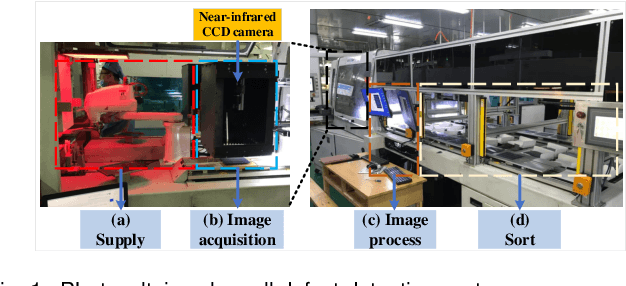
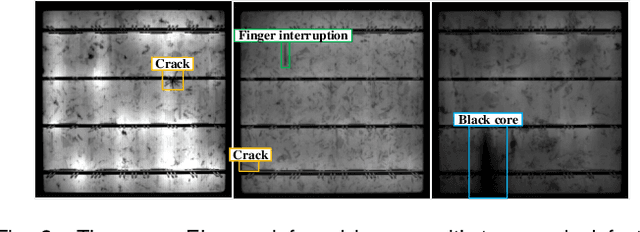
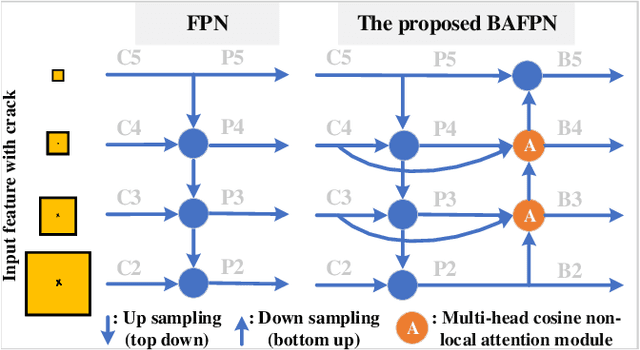
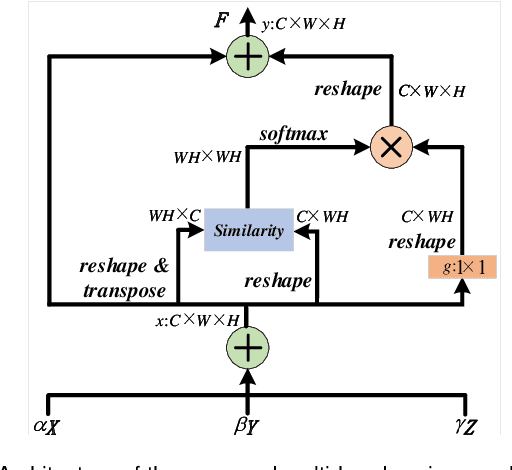
Abstract:The multi-scale defect detection for solar cell electroluminescence (EL) images is a challenging task, due to the feature vanishing as network deepens. To address this problem, a novel Bidirectional Attention Feature Pyramid Network (BAFPN) is designed by combining the novel multi-head cosine non-local attention module with top-down and bottom-up feature pyramid networks through bidirectional cross-scale connections, which can make all layers of the pyramid share similar semantic features. In multi-head cosine non-local attention module, cosine function is applied to compute the similarity matrix of the input features. Furthermore, a novel object detector is proposed, called BAF-Detector, which embeds BAFPN into Region Proposal Network (RPN) in Faster RCNN+FPN to improve the detection effect of multi-scale defects in solar cell EL images. Finally, some experimental results on a large-scale EL dataset including 3629 images, 2129 of which are defective, show that the proposed method performs much better than other methods in terms of multi-scale defects classification and detection results in raw solar cell EL images.
 Add to Chrome
Add to Chrome Add to Firefox
Add to Firefox Add to Edge
Add to Edge